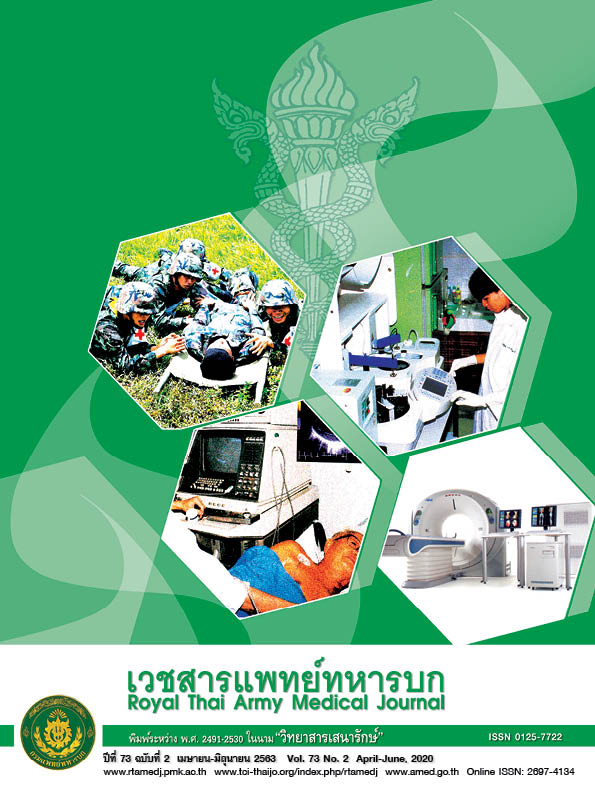การส่องกล้องตรวจในกระเพาะปัสสาวะหกเดือนภายหลังการผ่าตัดใส่ตาข่ายเพื่อซ่อมแซม ช่องคลอดด้านหน้า-การศึกษาแบบตัดขวาง
Main Article Content
บทคัดย่อ
บทนำ: ภาวะตาข่ายโผล่เป็นภาวะแทรกซ้อนที่พบได้บ่อยหลังการผ่าตัดใส่ตาข่ายเพื่อซ่อมแซมผนังช่องคลอด
วัตถุประสงค์: เพื่อศึกษาสิ่งผิดปกติภายในกระเพาะปัสสาวะที่สัมพันธ์กับการผ่าตัดใส่ตาข่ายเพื่อซ่อมแซมช่องคลอดด้านหน้า และปัจจัยที่เกี่ยวข้องในผู้ป่วยที่ไม่มีอาการผิดปกติของระบบทางเดินปัสสาวะส่วนล่าง
วิธีการ: ทำการศึกษาแบบตัดขวางในผู้ป่วยที่ได้รับการผ่าตัดใส่ตาข่ายเพื่อซ่อมแซมช่องคลอดด้านหน้าตั้งแต่ 6 เดือนขึ้นไป โดยเก็บข้อมูลพื้นฐาน ข้อมูลทางคลินิก ตรวจปัสสาวะ ตรวจภายใน และส่องกล้องในกระเพาะปัสสาวะด้วยกล้องชนิดแข็ง 30 องศา เพื่อดูภาวะตาข่ายโผล่และความผิดปกติอื่นๆ ในกระเพาะปัสสาวะ
ผลการศึกษา: ผู้ป่วย 100 คน มีค่ามัธยฐานของอายุ 68 ปี (43 ถึง 84 ปี) ระดับการหย่อนของช่องคลอดด้านหน้ามีค่ามัธยฐาน 3 (2 ถึง 4) ไม่พบภาวะตาข่ายโผล่ในกระเพาะปัสสาวะหรือความผิดปกติที่สัมพันธ์กับการผ่าตัด (ค่าช่วงความเชื่อมั่นที่ระดับร้อยละ 95: ร้อยละ 0 ถึง 3.7) แต่พบแผล Hunner และ glomerulation 1 ราย พบกระเพาะปัสสาวะโป่งพองและมี trabeculae เพิ่มขึ้น 1 ราย
สรุป: ไม่พบภาวะตาข่ายโผล่ในกระเพาะปัสสาวะหรือความผิดปกติที่สัมพันธ์กับการผ่าตัด ดังนั้นอาจไม่จำเป็นต้องส่องกล้องในกระเพาะปัสสาวะหลังการผ่าตัดใส่ตาข่ายในผู้ป่วยที่ไม่มีอาการของระบบทางเดินปัสสาวะส่วนล่างทุกราย
Downloads
Article Details
บทความในวารสารนี้อยู่ภายใต้ลิขสิทธิ์ของ กรมแพทย์ทหารบก และเผยแพร่ภายใต้สัญญาอนุญาต Creative Commons Attribution-NonCommercial-NoDerivatives 4.0 International (CC BY-NC-ND 4.0)
ท่านสามารถอ่านและใช้งานเพื่อวัตถุประสงค์ทางการศึกษา และทางวิชาการ เช่น การสอน การวิจัย หรือการอ้างอิง โดยต้องให้เครดิตอย่างเหมาะสมแก่ผู้เขียนและวารสาร
ห้ามใช้หรือแก้ไขบทความโดยไม่ได้รับอนุญาต
ข้อความที่ปรากฏในบทความเป็นความคิดเห็นของผู้เขียนเท่านั้น
ผู้เขียนเป็นผู้รับผิดชอบต่อเนื้อหาและความถูกต้องของบทความของตนอย่างเต็มที่
การนำบทความไปเผยแพร่ซ้ำในรูปแบบสาธารณะอื่นใด ต้องได้รับอนุญาตจากวารสาร
เอกสารอ้างอิง
2. Haylen BT, Maher CF, Barber MD, Camargo S, Dandolu V, Digesu A, et al. An International Urogynecological Association (IUGA) / International Continence Society (ICS) joint report on the terminology for female pelvic organ prolapse (POP). Int Urogynecol J. 2016;27(2):165-94.
3. Hendrix SL, Clark A, Nygaard I, Aragaki A, Barnabei V, McTiernan A. Pelvic organ prolapse in the women's health initiative: Gravity and gravidity. Am J Obstet Gynecol. 2002;186(6):1160-6.
4. Gopinath D, Radley SC. Complications of polypropylene mesh in prolapse surgery: an update. Obstet Gynecol Reprod Med. 2013;23(10):300-6
5. Olsen AL, Smith VJ, Bergstrom JO, Colling JC, Clark AL. Epidemiology of surgically managed pelvic organ prolapse and urinary incontinence. Obstet Gynecol. 1997;89(4):501-6.
6. Quemener J, Joutel N, Lucot JP, Giraudet G, Collinet P, Rubod C, et al. Rate of re-interventions after transvaginal pelvic organ prolapse repair using partially absorbable mesh: 20 months median follow-up outcomes. Eur J Obstet Gynecol Reprod Biol. 2014;175:194-8.
7. Abbott S, Unger CA, Evans JM, Jallad K, Mishra K, Karram MM, et al. Evaluation and management of complications from synthetic mesh after pelvic reconstructive surgery: a multicenter study. Am J Obstet Gynecol. 2014;210(2):163 e1-8.
8. Stergios K, Doumouchtsis MMF. Mesh Complications in Prolapse Surgery. In: Cardozo L, Staskin D, eds. Textbook of Female Urology and Urogynecology. 4th ed. London: Informa Healthcare, 2010: 846-54.
9. Maher C, Feiner B, Baessler K, Schmid C. Surgical management of pelvic organ prolapse in women. Cochrane Database Syst Rev. 2013(4):CD004014.
10. Zambon JP, Badlani GH. Vaginal Mesh Exposure Presentation, Evaluation, and Management. Curr Urol Rep. 2016;17(9):65.
11. Wong V, Shek KL, Goh J, Krause H, Martin A, Dietz HP. Cystocele recurrence after anterior colporrhaphy with and without mesh use. Eur J Obstet Gynecol Reprod Biol. 2014;172:131-5.
12. Abed H, Rahn DD, Lowenstein L, Balk EM, Clemons JL, Rogers RG, et al. Incidence and management of graft erosion, wound granulation, and dyspareunia following vaginal prolapse repair with graft materials: a systematic review. Int Urogynecol J. 2011;22(7):789-98.
13. Anger JT, Khan AA, Eilber KS, Chong E, Histed S, Wu N, et al. Short-term outcomes of vaginal mesh placement among female Medicare beneficiaries. Urology. 2014;83(4):768-73.
14. Menchen LC, Wein AJ, Smith AL. An appraisal of the Food and Drug Administration warning on urogynecologic surgical mesh. Curr Urol Rep. 2012;13(3):231-9.
15. Schimpf MO, Abed H, Sanses T, White AB, Lowenstein L, Ward RM, et al. Graft and Mesh Use in Transvaginal Prolapse Repair: A Systematic Review. Obstet Gynecol. 2016;128(1):81-91.
16. Reisenauer C, Viereck V. Mesh-related complications in urogynecology - a multidisciplinary challenge. Acta Obstet Gynecol Scand. 2012;91(7):869-72.
17. Wu MP. The Use of Prostheses in Pelvic Reconstructive Surgery: Joy or Toy? Taiwan J Obstet Gynecol. 2008;47(2):151-6.
18. Haylen, BT, Freeman RM, Swift SE, Cosson M, Davila GW, Deprest J, et al. An International Urogynecological Association (IUGA)/International Continence Society (ICS) joint terminology and classification of the complications related directly to the insertion of prostheses (meshes, implants, tapes) and grafts in female pelvic floor surgery. Neurourol Urodyn. 2011; 30(1): 2-12.
19. Frenkl TL, Rackley RR, Vasavada SP, Goldman HB. Management of iatrogenic foreign bodies of the bladder and urethra following pelvic floor surgery. Neurourol Urodyn. 2008;27(6):491-5.
20. Lo TS, Pue LB, Tan YL, Khanuengkitkong S, Dass AK. Delayed intravesical mesh erosion in a midurethral sling following further mesh-augmented pelvic prolapse surgery. J Obstet Gynecol Res. 2014;40(3):862-4.
21. Bjelic RV, Aigmueller T, Preyer O, Ralph G, Geiss I, Müller G, et al. Vaginal prolapse surgery with transvaginal mesh: results of the Austrian registry. Int Urogynecol J. 2014;25(8):1047-52.


